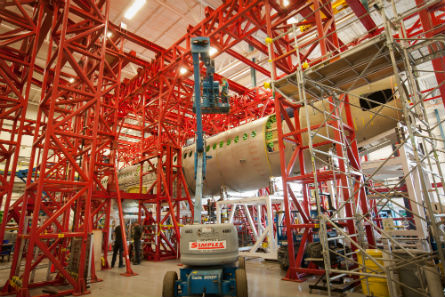Bombardier confirms the final section for the CSeries structural test aircraft will be delivered to the Montreal factory by the end of the month, and final assembly should be "pretty much complete" by the end of October.
With the first flight test vehicle (FTV-1) following in production, finishing the complete airframe static test (CAST) aircraft is a critical step towards reaching first flight in less than 107 days.
Bombardier is encouraged that its CSeries manufacturing team completed assembly of the CAST fuselage more than 50% faster than expected, says Rob Dewar, vice president and general manager for CSeries.
"This was the first time we used a manufacturing team to assemble a structural test article and the reason we did that was for them to get the learning," Dewar says. "They did it in less than half the time planned."

The schedule appears to have slipped slightly from dates provided by programme officials in late June. At that time, Dewar said the CAST would be assembled in September and static testing would begin in October.
Although Bombardier's schedule still calls for first flight by end-year, top executives have said that a three to six-month slip would not be considered a true delay by customers.
Mike Arcamone, president of Bombardier Aerospace, has instead focused attention on the entry-into-service milestone with an undisclosed launch customer by the end of 2013.
The entry-into-service date is usually expected to follow about 12 months after first flight, but Bombardier has invested heavily in ground simulation systems that could shorten the timeline to achieve airworthiness certification.
In August, Bombardier fully activated the integrated systems test and certification rig (ISTCR), which the company considers the most advanced "iron bird" ground simulator ever built in the aerospace industry. Running simulations on the ISTCR could validate airworthiness tests that would otherwise have to be validated in flight tests. The amount of the credit will depend on continuing negotiations with Transport Canada, the certification authority for the CSeries.
"It's all contingent on the correlation of the representation of how the systems test on the ground versus how it works in the air," Dewar says. "So, if they correlate, then we'll be able to get credit for the various tests."
Source: Air Transport Intelligence news























